Col. William F. Cody searched for Wyoming black gold.
Col. William F. “Buffalo Bill” Cody’s legacy extends beyond his famous Wild West show. A Wyoming town named Cody preserves his Big Horn Basin heritage, but less known is his adventure into the oil business.
“Buffalo Bill’s Wild West and Congress of Rough Riders of the World” once made W.F. Cody the most recognized man in the world. His fanciful Indian attacks on wagon trains, the marksmanship by Annie Oakley, and other attractions drew audiences in America and Europe.

“It would be hard to imagine the history of Wyoming around the turn of the 20th century without Buffalo Bill,” notes one historian. 1915 photo courtesy Buffalo Bill Center of the West.
Cody became a promoter of the Wyoming frontier town he helped found in 1896 that bears his name. The local newspaper he and a partner started in 1899 is still publishing today. The Cody Enterprise continues to acknowledge W.F. Buffalo Bill Cody on its masthead.

A “Buffalo Bill Wild West show circa 1899” poster by Courier Lithographing Co., Buffalo, N.Y., shows cowboys rounding up cattle and a portrait of Col. W.F. Cody on horseback. Image courtesy Library of Congress Prints and Photographs Division.
As a partner in the Shoshone Land and Irrigation Company, he enticed the Chicago, Burlington and Quincy Railroad to build an extension from Toluca, Montana, to Cody to ensure future growth and prosperity in the Big Horn Basin of north-central Wyoming.
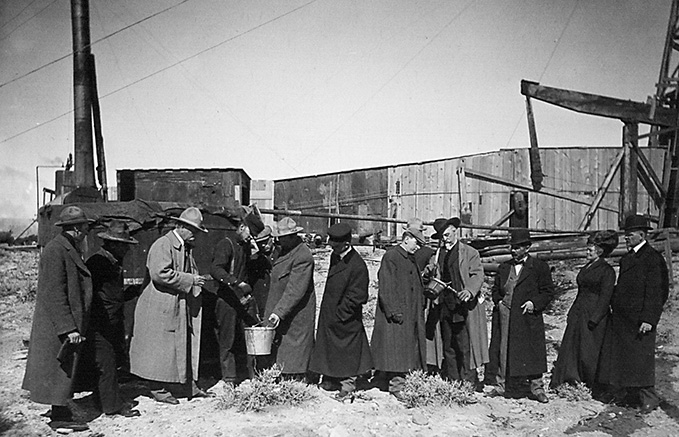
W.F. “Buffalo Bill” Cody, right of center in black hat, and other investors at an oilfield on the Shoshone Anticline near Cody, Wyoming, around 1910. Photo courtesy the American Heritage Center, University of Wyoming.
Always an entrepreneur, the showman had earlier formed the W.F. Cody Hotel Company when the railroad reached Sheridan, about 150 miles east of Cody, in 1892. He opened the Irma Hotel (named after his daughter) in Cody in 1902. Historian Robert Bonner reported the veteran showman would promote his enterprises endlessly with anyone who would listen.
“He saw great possibilities in every direction, and he had an unquestioned faith in his personal ability to achieve whatever he set out to do,” explained Bonner in a 2007 book about the famed showman. “He was always willing to back up his words with his money.”
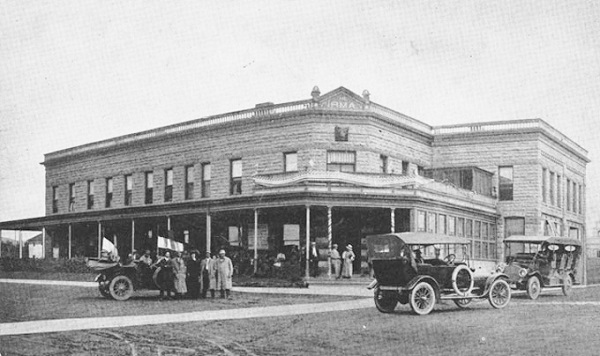
The Irma Hotel in Cody, shown here circa 1920, opened in 1902 and remains open today. It was named for the daughter of William F. “Buffalo Bill” Cody. Photo courtesy of Lynn Johnson Houze, WyoHistory.org.
The Burlington and Quincy line opened in Cody, population about 300, in November 1901. The train depot was on the north side of the Shoshone River, across from the town.
Meanwhile, an oil discovery ten months earlier in a small Texas town had launched America’s greatest drilling frenzy, one that would create the modern petroleum industry. Perhaps inspired by the oil gusher at Spindletop near Beaumont, which would lead to hundreds of new Texas oil companies, Buffalo Bill and associate George Beck began searching for oil near Cody.
Searching for “Black Gold”
The fledgling oilmen began by using the same “placer claim” Wyoming statutes applied to gold and silver. State law required that at least $500 had to be spent annually on development of each 160-acre claim.
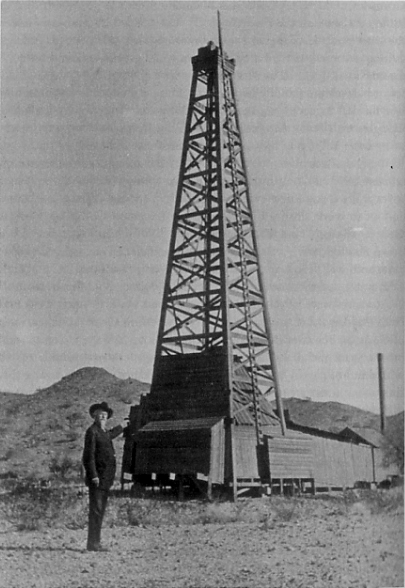
“Bill, the Oil King” stands by one of his cable-tool wells drilled near Cody, Wyoming. Photo courtesy Buffalo Bill Center of the West.
Buffalo Bill’s prior disappointments in mining did not hamper his energetic promotion of the venture and search for investors — including Wyoming congressman Rep. Frank Mondell, among others. He and his partners formed the Cody Oil Company in October 1902. Cody Oil Company drilled its first well at an oil springs just two miles from the town Buffalo Bill founded.
By August 1903, the well had reached 500 feet and was progressing well enough to prompt spudding another. But water encroachment ruined both well boreholes — and dampened Buffalo Bill’s enthusiasm for the petroleum exploration. Six years later, Buffalo Bill and his associates once again ventured into the oil business by forming the Shoshone Oil Company.
Undeterred by the failure of Cody Oil, Rep. Frank Mondell and others invested in the new exploration venture. Buffalo Bill bought 2,500 shares of Shoshone Oil stock at $1 each; his partner Beck bought 46,666 shares. In 1909, the exploration company filed for 115 oil placer claims south of Cody.
Meanwhile, Buffalo Bill energetically promoted his Wyoming “Bonanza Oil District” to potential investors back East.
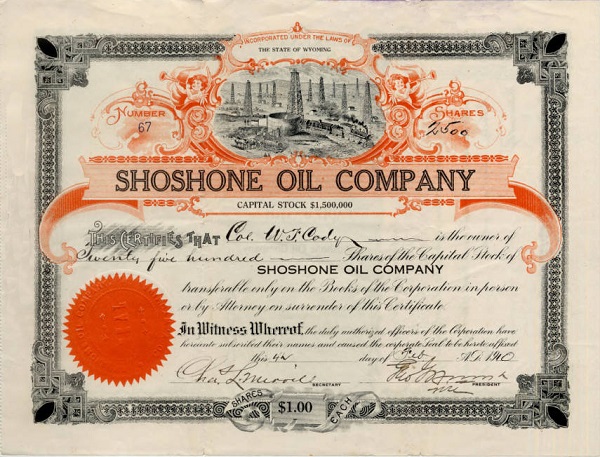
A stock certificate for 2,500 shares valued at $1 per share issued to W. F. Cody by Shoshone Oil Company, Cody, Wyoming, on February 4, 1910. Shoshone Oil Company today survives only as a collectible stock certificate. Image courtesy Buffalo Bill Center of the West.
According to Bonner’s book, during a visit to New York City in the spring, the famous Cody oilman carried pocket flasks of oil to show his friends in the East and to interest investors. “With what degree of seriousness we cannot know,” writes the author, some of his eastern friends called him, “Bill, the Oil King.”
Unfortunately for Shoshone Oil Company, all the major oil strikes were found north and east of town; nothing of significance on the company’s placer claims. If the exploration company had drilled farther south and a little east of Cody, it may have found the northernmost extension of the prolific Oregon Basin.
Wyoming’s Oregon Basin field, discovered in 1912, would produce almost 500 million barrels of oil and 300 million cubic feet of natural gas in the coming decades, according to the Wyoming Oil and Gas Conservation Commission.
Shoshone Oil Company has survived as collectible stock certificates.
In 1915, two years before his death, Buffalo Bill promoted a new oil venture, writing to an acquaintance, “Don’t you and some of your friends want to come in on the ground floor — and make a real clean up?”
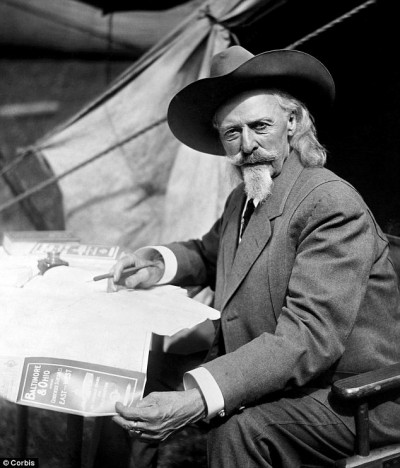
Col. W.F. “Buffalo Bill” Cody was preparing for another exploration venture into the Wyoming oil patch when he passed away in 1917.
A plan to form the Buffalo Bill Oil & Gas Company apparently came to naught. As he prepared for further exploration ventures into the Wyoming oil patch, Col. W.F. “Buffalo Bill” Cody died in Denver on January 10, 1917.
“It would be hard to imagine the history of Wyoming around the turn of the twentieth century without Buffalo Bill,” concluded Bonner in his 2007 book. “He brought enormous, electric energy into the Big Horn Basin and the state as a whole.”
Founded in Cody the same year Buffalo Bill died, the Buffalo Bill Memorial Association opened the Buffalo Bill Historical Center in 1927, renamed in 2013 the Buffalo Bill Center of the West.
By the early 1920s, Wyoming’s Salt Creek oilfield in Natrona County became one of the most productive in the nation. Learn more in First Wyoming Oil Wells.
_______________________
Recommended Reading: William F. Cody’s Wyoming Empire: The Buffalo Bill Nobody Knows (2007); The Salt Creek Oil Field: Natrona County, Wyo., 1912 (reprint, 2017); Kettles and Crackers – A History of Wyoming Oil Refineries
(2016). Your Amazon purchases benefit the American Oil & Gas Historical Society. As an Amazon Associate, AOGHS earns a commission from qualifying purchases.
_______________________
The American Oil & Gas Historical Society (AOGHS) preserves U.S. petroleum history. Become an AOGHS annual supporting member and help maintain this energy education website and expand historical research. For more information, contact bawells@aoghs.org. Copyright © 2024 Bruce A. Wells. All rights reserved.
Citation Information – Article Title: “Buffalo Bill Shoshone Oil Company.” Authors: B.A. Wells and K.L Wells. Website Name: American Oil & Gas Historical Society. URL: https://aoghs.org/oil-almanac/buffalo-bill-oil-company. Last Updated: January 27, 2024. Original Published Date: April 29, 2014.


